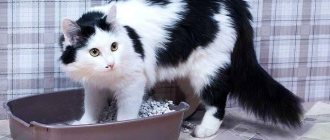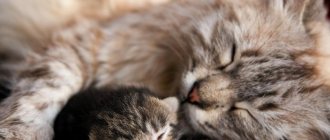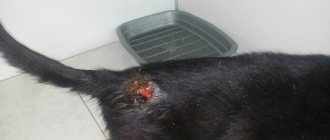A fluffy pet delights the child and improves the mood of the parents. If a family notices that the cat is wheezing and coughing, as if choking, or that the cat is making strange sounds, they are very worried and do not know what to do to help the pet. A symptom that frightens pet owners occurs both with serious diseases that require immediate elimination, and with ingestion of hair, from which the pet gets rid of itself.
Diagnostics
Having studied the external symptoms of cough, we proceed to diagnosis:
- conduct an external examination of the body, listen for wheezing and noises;
- evaluate cardiac activity;
- take blood for analysis;
- do an X-ray examination of the sternum;
- a culture of secretions or sputum is collected to identify the causative agent of inflammation;
- examine the affected organ for oncology (if suspected).
In clinics, it is possible to examine the entire animal’s body by different specialists and conduct an X-ray examination with a contrast agent.
Why does a cat wheeze when breathing?
Wheezing during breathing is not a disease, it is always a symptom of some kind of pathology. There are crepitating rales, blistering and dry. All of them are characteristic of certain diseases.
Crepitating wheezing, also known as crackling, accompanies pneumonia and atelectasis; bubbly, or wet, observed with bronchitis and pulmonary edema; dry wheezing is characteristic of diseases of bronchospasm and bronchitis. You can also distinguish a separate type of wheezing - the so-called whistling. It is usually observed when the glottis is paralyzed or foreign particles enter the trachea.
Sign up for a diagnosis of the causes of wheezing
How to provide first aid to a choking pet
First aid methods depend on the cause of the illness. In case of short-term disturbance, breathing often normalizes on its own, but in case of long-term disturbance, followed by cardiac arrest, the animal may require artificial respiration and indirect massage.
Basic steps
For physiological reasons, the pet simply needs to be given time to catch its breath and calm down. If overheating is to blame, be sure to offer a bowl of water and cool the areas where large vessels pass (neck, inner thighs, groin) with a cold compress. It is also recommended to open all doors and windows to create a draft.
If the cat is breathing heavily and wheezing, carefully examine his throat and check the integrity of the ribs. If you find a foreign body or injury, go to the veterinary clinic immediately. Self-help can result in accidentally pushing the found bone or other object even deeper, so it’s better not to take risks here.
Thus, the main actions are limited to normalizing body temperature, ventilating the room and calming the animal. The only exception is sudden cardiac arrest, as well as poisoning, provided its cause is known.
Is it possible to do artificial respiration?
If a cat loses consciousness and does not respond to light, then it requires urgent resuscitation. The rescue operation must begin within 2-3 minutes after the heart has stopped. In such a critical situation, it is very important not to panic, immediately call a veterinarian at home, and then strictly follow the following algorithm:
- Place the animal on its right side and extend its neck in line with the body. This will facilitate air flow.
- Clean the oral cavity from accumulated secretions with a napkin or gauze and close the mouth tightly. Removing mucus will help your pet avoid choking once breathing returns to normal.
- Inhale more air, place your curled palm on the cat’s nose and gently exhale into his nostrils. The frequency of inhalations depends on the size of the animal. With average settings, 20 times per minute is enough. The kitten will need more frequent but less intense repetitions.
- Check your pulse every 20 seconds. When breathing stops, the heart temporarily continues its work, so indirect massage is not required in all cases. If the heartbeat has really stopped, move on to the next step.
- Place one hand on the cat's chest, holding it between the thumb and the other four fingers.
- Perform several quick and rhythmic pressing movements with a break of 5 seconds, remembering to alternate them with artificial respiration. For every 30 movements there should be 2 breaths.
If possible, the rescue operation is best carried out in pairs. Once the heartbeat resumes, the animal cannot be moved, so at this point you just need to wait for the veterinarian.
The cat is choking and wheezing: what to do
The cat is breathing frequently: reasons and how you can help
You need to open the mouth and pull the tongue forward, check the throat for foreign objects that should be removed, including mucus or vomit. This will help clear your airways. To do this, hold the cat by its hind legs and raise its head.
Important! If you suspect a spinal injury, you should not lift or move the animal.
If removal of the foreign body does not help, you must begin first aid.
First aid for respiratory arrest
Step-by-step instruction:
How to give artificial respiration to a cat
- Start artificial respiration: lay the cat on its side, pull the tongue forward, cover the mouth with your hand and straighten the neck. Air is inhaled through the cat's nose every 3 seconds. It is important that the chest rises, but does not arch from excess inhaled air.
- During artificial respiration, you need to check for a heartbeat. If the heart is beating but there is no breathing, you need to inhale air at a rate of 10 breaths per minute until the cat breathes on its own.
- If you are completely sure of cardiac arrest, begin chest massage.
- If respiratory arrest is detected and resuscitation begins, it is important that someone call a veterinarian or take the cat and its owner to the clinic.
Important! Cardiopulmonary resuscitation should not be performed if the cat is conscious.
Instructions on how to perform chest compressions on a cat
First aid
In addition to the above private signs, the cat owner’s anxiety and concern should be caused by the following symptoms, common to all conditions that threaten the pet’s life:
- the cat is apathetic and lethargic;
- frequent vomiting;
- cough is dry or with bloody sputum;
- the cat shows signs of anxiety and fear.
If these symptoms are present in addition to difficulty breathing, the most effective help for your pet will be to take him to the clinic as soon as possible or call a doctor at home. During transportation or while waiting for help, the cat should be placed on its side and, if possible, its mobility should be limited.
It should be remembered that you cannot hesitate and waste time. Prolonged hypoxia entails irreversible changes in the brain, which will lead to the death of the pet.
What is wheezing
This concept implies a whole complex of characteristics. The main one is the noisy breathing pattern, which is not typical for the cat's normal state.
Before the wheezing begins, the cat usually becomes silent. It is this unusual silence instead of meowing that immediately attracts the owner’s attention. If the cat stops meowing and begins to wheeze, hissing or whistling sounds can be clearly heard against the background of breathing noises.
Any veterinarian will tell you that such a deviation from the norm in most cases signals some kind of pathology of the respiratory tract.
Sometimes wheezing is understood as a hoarse voice, a drying up of the timbre of sounds that a pet makes. The extreme degree of development of the problem is considered to be the situation when the cat cannot meow, only wheezes. This happens when the vocal cords are not completely closed due to a large amount of accumulated mucus.
This symptom indicates the development of an inflammatory process.
Classification of wheezing
The characteristic features of wheezing directly depend on the cause that caused it. It may be pulmonary or extrapulmonary.
The first group of factors is associated with pathological processes in the animal’s respiratory system. These include: inflammatory processes in the bronchi, respiratory tract injuries, diaphragmatic hernia, pulmonary edema.
Extrapulmonary wheezing, including vomiting, is caused by organ pathologies that affect the respiratory system. With cardiovascular diseases, cats do not cough, but they breathe frequently and heavily.
A variety of cardiomyopathies, kidney problems, and oncology lead to the appearance of wheezing. Quite often, a cat begins to wheeze due to allergies or mechanical injury.
The wheezing itself is:
- wet;
- dry;
- crepitant;
- whistling.
Moist rales are divided into small-bubble, large-bubble and medium-bubble. This refers to bubbles that form as inhaled air passes through a layer of accumulated mucus. Wheezing occurs when the blisters burst.
Dry wheezing may be whistling or buzzing. The air swirling in the narrowed lumen of the bronchi creates noise of various types. If there is mucus in the bronchi, it obstructs the movement of air and a buzzing sound is heard. In the absence of mucus, wheezing is accompanied by a quiet whistle.
Heart problems
Many people do not know what to do if a cat coughs and wheezes, for what reason this reflex occurs. A serious reason to see a doctor is the occurrence of heart problems. Most often, this disease occurs in old and overweight animals. At first, coughing rarely bothers the animal, but later it inevitably becomes more frequent.
The disease is diagnosed by tactile and visual examination. The pet's blood pressure is measured, electrocardiography and radiography are performed. Such a disease requires lifelong care for the animal and maintenance therapy. Treatment is prescribed by a veterinarian based on the research results obtained. Giving medications at your own discretion is strictly prohibited.
The cat must be provided with rest, proper nutrition and follow the doctor's instructions. For animals with this pathology, special dietary foods are sold in pharmacies.
Electronic cigarettes are no more harmful than regular ones, but...
The mortality rate for EVALI is low. The experience of foreign colleagues shows that the majority of patients affected by vaping successfully recovered 2-3 weeks after a course of intensive steroid therapy and complete cessation of electronic cigarettes.
The biopsy results of the patients showed no signs of oncological changes. However, at the moment it is impossible to draw unambiguous conclusions in this direction. Electronic cigarettes and vaping are no more harmful than tar cigarettes. The harm of the latter manifests itself gradually, and the list of diseases caused by tobacco products includes emphysema, obstructive pulmonary disease, cancer, strokes and a number of pathologies of the cardiovascular system.
In patients with EVALI, the harm from vaping and e-cigarettes appeared quickly - already within the first month, the victims were bothered by cough, shortness of breath, gastrointestinal upset and asthenia.
Why is a cat breathing heavily and frequently: non-dangerous reasons
Tachypnea, or rapid, heavy breathing, occurs in a cat when there is a lack of oxygen, or hypoxia. This condition is explained by 2 reasons: physiological and pathological.
Physiological causes are not life-threatening. These include various external and internal factors:
- Heat. A pet can overheat outside on a hot day or in a stuffy room with poor ventilation.
- Eating food quickly. Characteristic in the absence of saturation and prolonged fasting. Due to the too rapid absorption of food, breaths are taken in fits and starts, so the oxygen supplied with them is not enough.
- Fatigue after high physical activity. When performing intense movements, muscles require more oxygen, which is why shortness of breath often occurs while running.
- Overexcitement due to fear or aggression. In a state of stress, the body actively produces adrenaline, which speeds up the heart and the frequency of breathing. After calming down, the alarming symptoms disappear on their own.
- Hormonal changes. Occurs during estrus, pregnancy and childbirth. Treatment in these cases is not required, provided that the rest of the condition remains normal.
The risk group includes older cats and overweight cats. They get tired faster and often suffer from obesity due to inactivity.
How lung damage due to vaping is visualized on CT scans
Lung damage from e-cigarettes and vaping appears to resemble pneumonia on CT scans. EVALI is determined by “ground glass” (foci of infiltration and compaction of airborne lung tissue), localized mainly around the bronchi. Sometimes consolidation and a reverse halo symptom are also observed. Most often, the subpleural and lower lobe parts of the lungs are affected - symmetrically and on both sides.*
According to American doctors, all patients with EVALI note a gradual deterioration in their health, shortness of breath and increasing resistance to physical activity.
Causes of wheezing
There are many factors why a cat coughs. Among the main ones are allergic reactions, foreign bodies in the respiratory tract, bronchial asthma, helminths, inflammatory processes in the lungs, viruses and heart disease.
An allergic reaction in a cat occurs when an irritant enters the respiratory tract. Allergies can be caused by household dust, chemicals (detergents, aerosols, tray fillers), low-quality dry food and chemicals used for repairs.
Some cats suffer from allergies caused by seasonal flowering plants. Cough also occurs in cats whose owners smoke. When the animal breathes, gurgling and wheezing sounds can be heard.
Another cause of coughing in a cat is foreign objects stuck in the throat or nasal passages. These can be small bones and objects, as well as trichobezoars (balls of hair). In this case, the cat coughs and wheezes, trying to clear its throat and get rid of the irritating object.
Bronchial asthma is a dangerous condition of the animal’s body, the symptom of which is a strong, lingering cough and a general deterioration in the pet’s condition. Asthma is often associated with a genetic predisposition and can occur as a result of common allergies.
Cough can also be caused by helminthiasis. This is one of the most commonly diagnosed causes of animal cough.
Cat owners mistakenly believe that parasites exclusively affect the intestinal tract. In fact, lungworms are much more dangerous and often fatal, affecting the animal's respiratory system.
During breathing, the cat can hear wheezing, provoked by increased mucus production to quickly get rid of cysthelminths.
Pneumonia is a disease that affects the lower parts of the respiratory system. It usually occurs against the background of bacterial and viral infections of the respiratory tract, rarely developing independently. In addition to coughing, the animal experiences breathing disturbances, a large amount of sputum and mucus produced, a deterioration in the animal’s general condition and an increase in body temperature.
The cause of a specific reaction of the body in the form of a cough can be all kinds of viral infections that affect the nose, pharynx, bronchial tree and lungs. The most dangerous are viral rhinotracheitis and calcivirosis. In addition to coughing, the cat is diagnosed with apathy, depression of general condition and refusal to eat. Viral infections are often accompanied by an increase in body temperature to high levels.
Diseases of the heart muscle that provoke coughing are rarely diagnosed in domestic cats. If there is a disturbance in the functioning of the heart, the visible mucous membranes become cyanotic, shortness of breath and depression of the general condition are observed.
The owner of a mustachioed pet should carefully monitor the nature and strength of the cough, noting other accompanying symptoms. It is not recommended to self-medicate, since without an accurate diagnosis it is not possible to make a diagnosis and prescribe treatment. Moreover, by delaying a visit to a specialist, the owner only makes things worse. Especially when it comes to foreign bodies stuck in the respiratory tract, because the animal can die.
Causes of the phenomenon
A cat can choke for various reasons. This condition can be a completely physiological process, and the cat’s condition returns to normal without outside intervention. Physiological reasons are considered to be:
- Fear or severe stress can cause the animal to take a tense position, breathe frequently and nervously, and lick its lips. This phenomenon is short-lived and usually passes without consequences for the animal.
- Cats usually have very multiple pregnancies; at the end of gestation, the animal's uterus is so large that it puts pressure on the diaphragm. Shortness of breath appears, the cat moves with difficulty.
- If a cat is at high altitude, it experiences a lack of oxygen and may pant rapidly.
Symptoms of choking may occur as a result of injury. Such situations are especially common among street cats who like to sort things out. In this case, the symptoms of suffocation appear gradually, the cat becomes worse and worse. At first she breathes heavily, then sticks out her tongue, then apathy and lethargy sets in due to oxygen starvation. Also, with chest injuries, a cough may appear. In this case, there may often be no external damage in the form of torn pieces of fur or abrasions. But even a minor fracture of a rib when the bone rests against the chest can provoke suffocation.
Cats often suffocate due to foreign objects entering the respiratory tract. In this case, the situation may be so serious that it requires emergency assistance. At the same time, the cat breathes heavily, coughs, wheezes and cannot breathe air.
An animal can also suffocate due to poisoning. Especially if the pet has inhaled a toxic substance. Cats can be poisoned by anything: they can inhale powdered household chemicals, poison for rodents and insects, vapors of medications and much more. To relieve suffocation in case of poisoning, the animal should be immediately taken to a veterinarian.
It happens that cats are bitten by insects: wasps, bees, hornets. The cat tries to catch flying insects, and they, in turn, leave a sting in the animal’s mouth. The cat begins to choke. This condition is dangerous and requires help. A swollen tongue or palate can block the air supply to the throat, making it difficult for the animal to breathe.
Various pathological conditions can lead to a cat suffocating. They are usually accompanied by additional symptoms. For example, shortness of breath, cough, vomiting or diarrhea, lethargy, blueness of visible mucous membranes, extreme thirst and loss of appetite, increased urination. The cat's heart rhythm changes (fast or weak), and fluid may be released from the mouth or nose.
Let's look at the most typical diseases that can cause a cat to choke:
- Diseases of the nervous system. A pathology of the brain that affects the respiratory center can manifest itself in impaired breathing of the animal. A cat may choke after a head injury or as a tumor grows. This condition may be accompanied by vomiting, unsteadiness when walking, and other neurological signs.
- Respiratory diseases. A cat can breathe through its mouth if its nasal passages are blocked. With the growth of polyps or neoplasms in the nasal cavity or pharynx, the animal may breathe frequently and shallowly. This is usually accompanied by loss of appetite because the cat cannot smell the food. With the growth of tumors in the pharynx area, the cat may have difficulty swallowing and may choke when eating or choke. With pulmonary edema, bronchospasm and an asthmatic attack, the animal may suffocate to the point of suffocation. At the same time, the cat’s breathing is hoarse, gurgling sounds are heard, and a cough develops. The cat takes a forced pose. Without assistance, he may die.
- Tracheal collapse. A serious condition, it is more often observed in dogs, but cats are also susceptible to this disease. With this disease, softening and subsequent “collapse” of the cartilage tissue that makes up the tracheal rings occurs. Mucus accumulates in the trachea, breathing becomes heavy, and the cat “squelches” during inhalations and exhalations.
- Blood pathology. In severe anemia, the animal's body suffers from hypoxia. This causes him to increase his breathing. At the same time, the cat feels weak. He often licks his lips because he feels nauseous, there may be vomiting, and the visible mucous membranes are pale. The cat is apathetic.
- Breathing problems up to and including suffocation can develop as a result of carbon monoxide poisoning. In this case, the carbon monoxide molecule binds to the hemoglobin of red blood cells, instead of oxygen. A very stable compound is formed - carboxyhemoglobin. As a result, the tissues and organs of the cat’s body experience severe oxygen starvation. The cat reflexively begins to breathe rapidly, inhaling even more carbon monoxide, and ultimately dies.
- Abdominal ascites. The accumulation of fluid in the animal's abdominal cavity leads to pressure on the cat's diaphragm, and the animal's breathing becomes more rapid. In this case, the cat’s belly is bloated and the general condition is depressed.
- Heart pathology. When helminths enter the myocardial ventricles, heart failure and pulmonary embolism, the cat begins to suffocate. The animal may be in a forced position. There is no talk of motor activity, the cat is apathetic, her psyche is depressed. Possible refusal of food.
- Neoplasms that can be either benign or malignant. In this case, the cat does not suffocate immediately. Symptoms of suffocation begin if the formation is large in size and puts pressure on the respiratory system. More often, suffocation due to neoplasms occurs in old cats and animals with excess body weight.
Types of cough
Just like in humans, a cat’s cough is characterized by several criteria, thus being divided into types:
By duration:
- Chronic – lasts for months;
- acute – lasts several days.
By the nature of the discharge:
- wet;
- dry.
By volume:
- muted;
- weak;
- voiced.
By intensity:
- easy;
- hysterical, leading to vomiting.
By time of day:
- morning;
- evening.
By season:
- spring;
- autumn, etc.
When you observe your pet's cough, try to determine its type based on these parameters, so that you can then provide the doctor with a complete picture of the disease. Also pay attention to the time of day at which the cough peaks.
Therapeutic techniques
In the clinic, after clearing the airways, the veterinarian can start breathing using artificial respiration, inserting an endotracheal tube and connecting to a ventilator. An indirect cardiac massage, a defibrillator and injections of drugs (adrenaline, atropine, atipemazole, etc.) help a specialist to start a stopped heart. Depending on the results of resuscitation efforts, studies are prescribed to establish a diagnosis, treatment and further care.
Regular preventive examinations and tests will help identify diseases in the early stages, without leading them to a chronic form. If you have congenital or chronic diseases, you should follow your veterinarian's recommendations for caring for your cat. An attentive and caring owner will always notice suspicious symptoms and seek advice from a specialist, because the life and health of the cat is in his hands.
Helping a cat with choking
If your cat is choking, you should see a veterinarian as soon as possible. If it is not possible to show the animal to a specialist, try to quickly remove the object from the animal’s throat/mouth yourself (except for needles and sharp objects - only a veterinarian can remove them!). Be careful and attentive, as in this state the cat experiences panic and may become aggressive.
Secure your pet and place the index finger and thumb of one hand on his upper lip, pressing it against his jaw. With your other hand, open the cat's mouth. Gently pull on the tongue to examine the throat and mouth. Try removing the foreign object with tweezers. If something is stuck in the throat or esophagus, you can remove it by inducing vomiting in the cat (only if the animal has swallowed a non-sharp object!). Give him a teaspoon of water salted with ¼ teaspoon salt.
Vaseline oil will help you deal with a small foreign object (a blade of grass, a hair): pour 1 teaspoon of this liquid into the cat’s mouth. Vegetable oil can help remove a foreign object or at least move it into the stomach (give the cat 2-3 teaspoons).
If none of the above methods help, try the following: spread your legs wide, turn the cat upside down and shake vigorously. If there is no positive result, place the pet on its side, place your palms on the sides of its body behind the last ribs. Press sharply on the sides with your hands several times - the object should jump out of the animal’s mouth.
Signs of suffocation and foreign objects in the mouth
The following signs may indicate that a cat has a foreign object stuck in its throat:
- persistent cough;
- the cat salivates profusely;
- the pet is choking, suffocating.
If you notice these signs in your cat, check his mouth - there may be a foreign object there. If the pet is not given help, it may die from suffocation, which is accompanied by the following symptoms:
- cough and wheezing;
- the pet's eyes pop out of their sockets;
- the tongue and gums turn blue;
- the animal tries to put its paw into its mouth;
- loss of consciousness.
How to provide help at home?
With rhinotracheitis, cats do not stay in the clinic, but are sent home with the owner. To prevent your pet’s condition from worsening, carefully follow all the veterinarian’s recommendations. Under no circumstances treat a cat’s cough with “human” drugs to thin the sputum - this is very dangerous for the pet’s health.
In cases where a cat's eyes are affected by rhinotracheitis, it is prohibited to use any drops!
At home, it is necessary to provide the animal with:
- drinking plenty of water,
- balanced high-calorie diet,
- a cozy and warm place to relax,
- peace and quiet.
If the cat completely refuses to eat, then contact the veterinarian again - this is necessary to put on an IV and avoid the development of complications.
Causes of swelling
Laryngeal edema occurs as a response of the body to an allergen irritant. This reaction is individual - under the same conditions, the same stimulus can cause a serious condition in one person, but not affect another in any way. It depends on the characteristics of the immune system.
Allergens may be the following:
- medications, especially when administered intravenously and intramuscularly;
- pet hair;
- insect bites;
- fungi, mold;
- food (often nuts, milk, eggs, fish, some vegetables, fruits);
- chemical substances;
- dust, pollen.
When should I worry?
Your cat's wheezing breathing is nothing to worry about. However, it is important to consult a veterinarian to determine the cause of this condition and provide treatment if necessary.
If you see any of the following symptoms along with wheezing, contact your veterinarian immediately.
- Having difficulty catching my breath
- Cough or choking
- Very pale or bluish gums
- Dripping/collection of mucus in the mouth
- Signs of distress (asthma attack)
- Prolonged wheezing
- Very lethargic
What breathing is normal?
Normal breathing in a cat is a calm and uniform rise and fall of the chest, without jerks or convulsive movements. If a cat breathes from its stomach and sides, this means that the respiratory tract is impaired, and it is painful for the pet to breathe naturally. Worry should be caused by the appearance of wheezing or loss of voice.
If a cat wheezes, it means he is sick with something.
Note! If a cat wheezes quietly while breathing during sleep, and there are no convulsive sighs or wheezing, this is normal.
Diagnosis of respiratory organs
Diagnostic methods in the clinic are aimed at identifying the causes of choking, coughing and shortness of breath and consist of:
- collecting anamnesis (finding out medical history). At this moment, the main role is assigned to the cat's owner. It is he who must tell about the signs, frequency, rhythm, strength of cough and shortness of breath, how long ago the first case was recorded, whether there is discharge and what other signs were recorded in the animal; • examination and palpation (oral and nasal cavity, trachea and esophagus, thoracic cells for integrity);
- auscultation (listening) of the bronchi and lungs;
- thermometry;
- if necessary, chest X-ray examination;
- performing endoscopy of the trachea;
- carrying out bacterial culture of nasal secretions for subtitration of microflora sensitivity to antibiotics;
- general blood analysis;
- blood chemistry;
- ultrasound examination of the chest cavity;
- analysis of fecal matter for worm eggs;
- thoracentesis (taking the contents of the chest cavity for examination).
Of all the listed diagnostic methods at home, you can carry out inspection, palpation, thermometry and auscultation. Often these methods are not sufficient to establish a diagnosis and prescribe treatment.
Prevention
As preventative measures, as well as after an attack, it is recommended:
- strengthen immunity;
- perform moderate physical activity;
- use halotherapy and climatotherapy (stay at sea and in the mountains);
- use air purifiers;
- adhere to a diet excluding highly allergenic foods and products containing preservatives and chemical additives.
If you are concerned about breathing problems of any kind, we are always ready to provide assistance, make the correct diagnosis and begin treatment immediately. Call and make an appointment at the Ear, Nose and Throat Clinic!
How to treat wheezing breathing
Breathing with wheezing in a cat is treated in various ways and means. Depending on the type of disease, the doctor prescribes appropriate treatment.
Laryngeal edema is treated with medications that relieve swelling;
- — Brachiocephalic syndrome is usually eliminated surgically;
- — Pulmonary edema is relieved by intensive therapy, often requiring artificial ventilation;
- — Bronchitis is removed with antitussives;
- — Neoplasms and tumors are eliminated by chemotherapy (if amenable);
- — Foreign bodies are usually removed using an endoscope;
- — Laryngeal paralysis is eliminated through surgery.
The results of treatment if you go to the clinic in a timely manner are mostly positive.
Why is my cat breathing heavily with her mouth open?
If your cat is breathing heavily with her mouth open, it means she is very stressed or overheated. In some cases, difficulty breathing with your mouth open also indicates an underlying medical condition that you may not be aware of.
If your cat is panting with an open mouth, you should have her examined, as this may indicate the following serious conditions:
- Asthma
- Tumor
- Heart failure
- Cancer
- Lung damage and fluid accumulation around the lungs
Tags
if a cat coughs a panting cat in a cat licking fur, this is a cat before If a cat is not an adult cat can If a cat is in a hurry about a dog about a dog Dog breeds Dog health Dog nutrition Dog training Dog health behind a dog Why is a dog afraid of Dogs in cats. cat deaths occur in cats and Cat breeds Cat health Cat nutrition Cat behavior Health cats in cats and in cats and
dogbreedrodentsarticlerespiratoryservicesopen questioncontentsurgeonanswervaccinationbirddepartment











